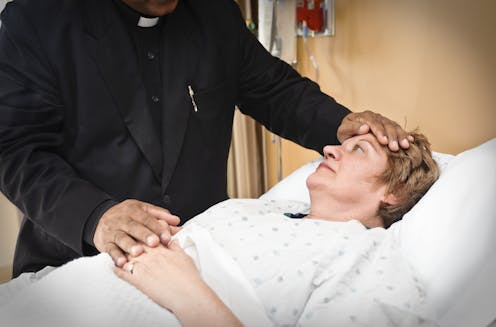
Several states around the U.S. are currently considering whether to legalize medical aid in dying for terminally ill patients. More than 20% of Americans already live in a state with access to a medically assisted death. Despite this rapidly changing legal climate, the language for describing this new way to die remains surprisingly antiquated.
The term that continues to dominate media coverage on the issue is “assisted suicide.” The American Medical Association uses the term “physician-assisted suicide.”
A quick look at Google Trends reveals that nine times as many people search for “assisted suicide” as opposed to “assisted dying.”
As a cultural anthropologist, I know that how we name something determines how we think about it. Until just recently, the primary term in the English language for the purposeful, voluntary death of oneself was “suicide.” Besides martyrdom or sacrifice, there was no other way to refer to an intentional self-death.
But times have changed. For the past 25 years, since Oregon enacted the country’s first assisted dying law, a medically assisted death has occupied a new legal and moral category. An assisted death is a medical response to the devastating reality of terminal illness.
Equating assisted dying with suicide isn’t only antiquated or misleading – it’s actually harmful. I have spent five years shadowing patients, families and physicians involved with assisted dying in America, and I saw how damaging this conflation can be. In my new book, “The Day I Die: The Untold Story of Assisted Dying in America,” I explore the complexities and constraints of the choices that people who pursue an assisted death face.
A loaded term
Until well into the 19th century, suicide was viewed as a crime in the United States, punishable with confiscation of the deceased’s property and denial of a Christian burial. Although suicide – but not its assistance – has been decriminalized today, it remains heavily stigmatized. As philosopher Ian Hacking writes, “News of a suicide among us has an immediate response: horror.” Calling assisted dying “suicide” taps into the social taboos and moral outrage that surround the act of taking one’s life.
That stigma can lead to very sick patients’ hiding their desire to pursue an assisted death from loved ones for fear of being judged for “suiciding” – leaving patients without critical support. It also poses a problem for terminally ill patients who have a strong wish to be released from their suffering but whose religion considers committing “suicide” a sin. One devout homeless patient from Portland with end-stage renal failure spent his last waking moments before he drank the lethal medication agonizing about whether God would forgive him for ending his life.
As I found during my research, the conflation of assisted dying with suicide sometimes causes families to feel isolated in the bereavement process. Afraid of being shamed for “abetting” their loved one’s “suicide,” some have had to mask their grief.
Valerie, whose elderly mother used Oregon’s assisted dying law in 2018, told her supervisor at work about her mother’s chosen death. He emitted a “hushed groan,” offering no condolences for her loss. “After that encounter, I only revealed the details to trusted friends and family,” Valerie told me. “It added a layer of sadness to expend energy trying to figure out what someone’s reaction might be.”
Bereavement experts call this type of mourning “disenfranchised grief” – hidden grief that is not fully acknowledged or even allowed by society because of the way someone died, such as from a drug overdose or in utero.
A medical procedure
From their inception, assisted-dying laws in America were designed to mobilize the tools of medicine to ease suffering at the end of someone’s life. These laws draw a clear line between assisted dying and a suicidal act. The nation’s first assisted-dying statute, Oregon’s 1997 Death with Dignity Act, specifies that “Actions taken in accordance with [the Act] shall not, for any purpose, constitute suicide, assisted suicide, mercy killing or homicide, under the law.”
As Roger Kligler, a physician and cancer patient who is suing the commonwealth of Massachusetts for his right to die, put it, “Calling it suicide means that we’re not talking about end-of-life issues.”
The participation of medicine and a patient’s social network, write psychiatrists John Michael Bostwick and Lewis Cohen, are what differentiate assisted dying from suicide. An assisted death is collaborative and sanctioned by a patient’s support system – not unilateral and covert. “When they acquiesce to requests to facilitate dying, [physicians] are not abetting suicide or committing homicide,” Bostwick and Cohen write. “The distinction between clinical suicide and other types of end-of-life decisions demands a new formulation.”
Key differences
Terminally ill patients who seek an assisted death aren’t suicidal. Absent a terminal prognosis, they have no independent desire to end their life. In fact, prescribing physicians must uphold the distinction between assisted dying and suicide in their clinical work by screening for mental illness, such as depression (which is clinically associated with suicidal thoughts). A patient who shows any signs of mental impairment must undergo further scrutiny by a mental health expert.
Patients who pursue medical aid in dying are no longer looking at an open-ended life span either. To qualify for an assisted death in states with these laws they must already be on the verge of dying – that is, within six months of the end of their life. These patients don’t face a meaningful decision between living and dying, but between one kind of death and another.
As more states are inching closer to legalizing assisted dying, it’s time that we revise and refine our cultural lexicon around this emergent end-of-life practice. A medically assisted death definitively warrants a linguistic and conceptual category of its own.
Anita Hannig does not work for, consult, own shares in or receive funding from any company or organization that would benefit from this article, and has disclosed no relevant affiliations beyond their academic appointment.
This article was originally published on The Conversation. Read the original article.







